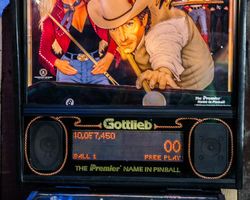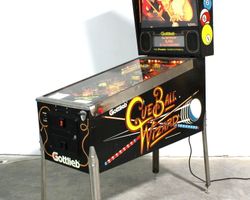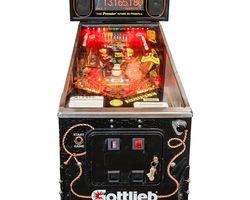Cue Ball Wizard

Average Prices: USD $600 to $1,600
Produced: October, 1992
Production Run: 5,700 units
Machine Type: Solid State Electronic
MPU: Gottlieb System 3
Players: 4
Design by: Jon Norris
Art by: Constantino Mitchell, David Moore
The pinball machine "Cue Ball Wizard," released in October 1992 by D. Gottlieb & Co., stands as a notable entry from the manufacturer's Premier Technology division. Designed by Jon Norris, with artwork contributed by Constantino Mitchell, David Moore, and Jeanine Mitchell, the machine brought a fresh billiards theme to the pinball arena. Dave Zabriskie composed the music, while Craig Beierwaltes crafted the sound design, and Rand Paulin handled the animations. Emerging during the era of Gottlieb's System 3 platform, "Cue Ball Wizard" was produced in a run of approximately 5,700 units, making it a relatively common yet distinctive title from the early 1990s. A unique aspect of the game's audio design is the incorporation of an impersonated voice, reminiscent of Clint Eastwood, adding a layer of character to the gameplay experience.
Signature Features and Design
"Cue Ball Wizard" distinguishes itself with several standout elements that directly influence gameplay. Central to its identity is the physical, full-sized cue ball positioned on the lower playfield, complemented by a real 8-ball. These elements are not merely aesthetic; the cue ball functions as a dynamic obstacle and a target, adding a layer of unpredictability to every shot. An oscillating captive ball kicker on an elevated mini-playfield further utilizes a captive ball, creating an interactive challenge. Two elevated standup targets on the main playfield are uniquely designed to be struck solely by the captive cue ball, forcing players to strategically manipulate the ball's movement across the table. This innovative use of physical objects enhances the game's core billiards theme, demanding adaptive play and offering a different experience compared to machines relying solely on static targets. The machine's visual identity reinforces its theme, with artwork depicting pool cues, billiard balls, and a general atmosphere of a bustling pool hall, although some players found the backglass artwork to be less inspired than the playfield itself.
Playfield and Mechanics
The "Cue Ball Wizard" playfield presents an open layout, providing a clear line of sight to various shots and targets. Key shots include a single ramp, the "Corner Pocket" eject hole on the left, and the "Side Pocket" represented by two green targets. The "Horseshoe," a curving tunnel, offers additional scoring opportunities, while "Bank Shot" eject holes provide points and random awards. The playfield is densely populated with interactive elements: two 7-bank drop targets for "Stripes/Solids," numerous standup targets (including the "Sweet Spot" and "No Way" targets), two bumpers, and four slingshots.
The strategic placement of these elements encourages a fluid gameplay experience. The design philosophy behind the layout aims to immerse the player in a billiards game, where precision and shot execution are paramount. For instance, the "POOL" lanes, one letter appearing in each outlane and inlane, guide players toward specific objectives. The full-sized captive cue ball often acts as a mobile barrier, requiring players to time their shots around its unpredictable movement or even use it to their advantage to hit the elevated targets. Despite some subjective comments regarding the lighting being "bland" or the DMD animations being "basic" by later standards, the playfield artwork consistently maintains the billiards aesthetic, with vibrant colors outlining shots and targets.
Gameplay Dynamics
"Cue Ball Wizard" offers engaging gameplay dynamics through a structured progression system and varied objectives. The machine features both a 2-ball and a 3-ball multiball mode, the latter known as "Pool Ball Mania."
A primary objective revolves around the "Wagon Wheel Rounds," which are activated by hitting the single ramp once it is lit. These rounds cycle through various challenges:
- Rowdy Ramp: Requires repeated ramp shots within a time limit for escalating points.
- Horseshoe Extra Ball: Awards an extra ball for a shot into the Horseshoe.
- No Way: Challenges players to hit the "No Way" target within a time limit.
- Spell Double: Advances letters towards "DOUBLE," which, once spelled, doubles scores and awards.
- Combo Shots: Demands a sequence of shots: ramp, bank shot, and Corner Pocket.
- Side Pocket: Focuses on hitting the Side Pocket repeatedly for points.
Completing all Wagon Wheel rounds initiates "Pool Ball Mania," the machine's 3-ball multiball mode, where every target on the playfield awards points, leading to high scores. Following "Pool Ball Mania" is "Nine Ball Play," a major scoring opportunity that involves knocking down drop targets before hitting the 8-ball (via the Side Pocket) to light the 9-ball drop target for a substantial reward. The 2-ball multiball is lit by clearing drop targets and then hitting the Side Pocket, which sends the 8-ball into color sets for jackpots.
Beyond the main modes, the game incorporates two video modes, activated by spelling "POOL." One is "Where's The King," where players choose between three curtains to find Elvis Presley for points, occasionally revealing a "cow pie" for zero points. The other requires players to "Catch the Pool Balls" falling from the top, both modes controlled by the flippers. The "Skill Shot" at the game's start involves aiming the 8-ball to hit the "BLUE" targets for points. Strategies often involve prioritizing the ramp to progress through Wagon Wheel rounds, strategically hitting bank shots for high points and awards, and effectively managing multiball phases to maximize scoring potential. The captive cue ball can be both a challenge and an asset, sometimes obstructing shots, but also enabling unique plays like striking the elevated targets.
Reception and Legacy
"Cue Ball Wizard" garnered a largely positive reception within the pinball community, often described as an enjoyable and engaging machine. Its gameplay is frequently lauded as "addictive," with an open playfield layout that provides a variety of shot opportunities. Players appreciated the straightforward rules, which made the game accessible for new players while still offering challenging skill shots for seasoned enthusiasts.
The machine's unique features, particularly the dynamic physical cue ball and 8-ball, are consistently highlighted as major strengths. This innovative use of physical objects introduced an element of unpredictability and skill that differentiated "Cue Ball Wizard" from other titles of its era. The strong billiards theme, complemented by appropriate sound effects and callouts, contributed to its immersive quality, making it a family-friendly game. Its value proposition is also often cited, frequently available at a reasonable price, which has cemented its reputation as a good acquisition. Furthermore, the inclusion of multiple modes, such as the rewarding drop targets and the progression through "Pinball Mania" and "9-ball play," provided depth and replayability. Its solid build quality and the reliability characteristic of Gottlieb's System 3 platform were also noted. Many consider "Cue Ball Wizard" to be an underrated game, offering a refreshing departure from common pinball themes and keeping players returning for additional games.
However, the machine was not without its criticisms. Some players found the callouts, such as "You sure need that ramp shot," and the music to be repetitive, becoming tiresome over extended play sessions. While the playfield lighting was generally deemed effective, some reviews pointed to the DMD animations as "basic" and the backglass artwork as "lackluster." Gameplay-wise, the very feature that defined its uniqueness—the captive cue ball—could occasionally be frustrating, obstructing shots or leading to unexpected drains. Certain modes or subgames were perceived as less engaging, and some players felt the scoring balance could be improved. The distinct feel of Gottlieb flippers, different from other manufacturers, was also a point of note for some. Additionally, a segment of the audience found the overall theme and music to be somewhat dated or "hokey," and the video modes received criticism for being poorly designed.
Despite these reservations, the prevailing sentiment for "Cue Ball Wizard" remains positive. Its combination of accessible yet challenging gameplay, innovative use of physical components, and a strong thematic execution secured its place as a distinctive and enjoyable title from Gottlieb's System 3 era. It stands as a testament to the creativity of early 1990s pinball design, providing a unique and enduring experience for a wide range of players.
Sponsored Links
 Ebay Listings
Ebay Listings
 Auction Results
Auction Results
| Cost | Location | Date |
|---|---|---|
| EUR €1,500 |  Hessen, Germany Hessen, Germany |
26 July, 2025 |
| USD $2,900 |  Georgia, United States Georgia, United States |
04 March, 2025 |
| USD $2,400 |  Georgia, United States Georgia, United States |
24 August, 2024 |
| USD $3,000 |  Michigan, United States Michigan, United States |
02 October, 2023 |
| GBP £1,500 |  Horley, United Kingdom Horley, United Kingdom |
20 August, 2023 |
| EUR €2,350 |  Niedersachsen, Germany Niedersachsen, Germany |
15 August, 2023 |
| USD $1,200 |  Virginia, United States Virginia, United States |
03 June, 2023 |
| USD $4,999 |  California, United States California, United States |
15 February, 2023 |
| USD $3,900 |  Florida, United States Florida, United States |
17 January, 2023 |
| USD $2,750 |  Vermont, United States Vermont, United States |
16 December, 2022 |


Private Policy · Search Website · Contact Us
As an eBay Partner, we may earn a commission from qualifying purchases made through links on this site, at no additional cost to you.
All trademarks and copyrighted materials remain property of their respective owners. All other content copyright 2007 - 2025 Pinpedia.







